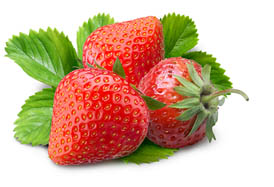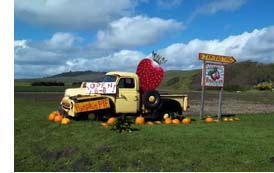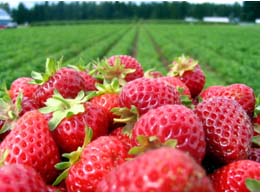How Broccoli Will Save Strawberries: Organic Farming Practices Leave Pesticides Aside
- By FruitGuys Staff
- Reading Time: 5 mins.
 Broccoli Shortcake. Mmmm, can you picture it? Golden cake, florets of green broccoli, and a cloud of sweet whipped cream… What? Doesn’t sound appealing? Do you prefer Strawberry Shortcake? But broccoli is what’s going to save strawberries from fungicides and other creepy chemicals.
Broccoli Shortcake. Mmmm, can you picture it? Golden cake, florets of green broccoli, and a cloud of sweet whipped cream… What? Doesn’t sound appealing? Do you prefer Strawberry Shortcake? But broccoli is what’s going to save strawberries from fungicides and other creepy chemicals.
Organic farming practices produce luscious, great tasting berries—without the pesticides or fungicides commonly used on conventional strawberry farms. Rotating crops in the fields is an ideal way to prevent pathogens from establishing a permanent residence and provide nutrients for the soil. Most fungi attack in summer, survive the winter as spores in the soil or plant litter, then attack again in the next growing season. So planting the same crops in the same fields year after year allows pathogens to build their populations.
Luckily there is an alternative to chemical warfare. Not only is broccoli good for humans, turns out it has natural anti-fungal properties that can protect strawberries. The brassica family, a genus in the mustard family that includes broccoli and cauliflower, bok choy, cabbage, and Brussels sprouts, has proven itself as a rotation crop that helps prevent molds that prey on berries. Davenport, CA-based Swanton Berry Farms (Santa Cruz County) has been employing this broccoli-strawberry rotation practice for 20 years with delicious results.
Get tips for your office
Be an office hero!

Who likes strawberries?
Strawberries are more popular than ever. In the past 20 years, fresh strawberry consumption per capita has nearly doubled; from 3.3 to 6.4 lbs a year. Strawberries are now the fifth highest consumed fruit in the United States, behind bananas, apples, oranges, and grapes, according to the U.S. Department of Agriculture. The United States is the world’s largest grower of strawberries for export, and California produces nearly three-quarters of them. Strawberries are now a $2.1 billion industry.
Some of California’s varieties are the Seascape, Camarosa, Albion, Aromas, Diamante and Ventana. Some East Coast and Mid-Atlantic varieties are Jewel, Cavendish, Earliglow, Redchief, and Tribute. Strawberries are a member of the Rose family and the only fruit with seeds on the outside. Although they are 90 percent water, they are a great source of dietary fiber, Vitamin C, folate, potassium, manganese, and antioxidants.

People of a certain age will remember that the strawberries of their childhood were much smaller (and possibly tasted better) than most berries sold today. Innovations in strawberry plant varieties have made berries less fragile (to survive to ship) and extended the growing season. Strawberries have a short growing season in temperate states, but warm climates in California and Florida allow production for 6-8 months a year. April, May, and June are still the peak harvest months. Technically, the strawberry is a perennial, but at commercial farms, it is planted as an annual, with new plants introduced each year. This is because a strawberry plant’s first growing year produces its biggest berries.
Want farm-fresh fruit?
We've got you covered.
Pests too
Everyone loves strawberries, including pests and fungi. Strawberries are fragile fruits that grow close to the ground and are vulnerable to penetration by bugs, molds, and disease. In warm climates, commercial farmers have strawberries growing in the same fields most of the year, year after year, so pathogens become a major problem. A common practice is to “fumigate” the soil to inoculate it against pests and mold that might damage the berries. The field is covered in a tarp, and the soil underneath is gassed to kill any pathogens. This leaves the soil sterile so it must be fertilized as well. Strawberries grown on the East Coast or in the north don’t have as many pathogen problems because of the ground freezes, a natural inoculation against pests.

The main pesticide used to fumigate strawberry fields was Methyl Bromide, an ozone-depleting chemical compound, that has also been found to cause cancer and birth defects in humans. While it was banned from common commercial use in 2010 as part of the U.S. agreement to the Montreal Protocol, the international treaty regarding ozone protection, a number of agricultural uses, including strawberry field fumigation, were excepted from the ban. Commercial use of Methyl Bromide was not finally phased out until about 2018. The proposed replacement, Methyl Iodide, was approved and then revoked for commercial use after public protests and lawsuits.
In order for the conventional strawberry industry to wean itself from the endless cycle of fumigants and fertilizers, they may have to cut back on production. “Essentially, in order to eliminate the use of fumigants, it would be necessary to reduce the production levels such that strawberries are grown 2-3 years out of 7, instead of the 5 of 7 that is more typical,” says Brett Malone, Executive Director at the Salinas, CA-based ALBA – Agriculture and Land-Based Training Association, a farm and non-profit whose mission is to “create greater economic opportunities for small farms while promoting ecological land management and healthy local foods.”
Want fruit for your office?
Get your office a free sample TODAY!
Brett says small-scale organic family farms are ideally suited to this new model of strawberry production and have shown it can be successful. “Based on our experience, we firmly believe that small scale organic strawberry production is viable, especially if combined with other annual crops that provide a means to carry out crop rotation and diversify production and markets,” said Brett.

In its 2010 “Shopper’s Guide to Pesticides,” the Environmental Working Group listed conventionally grown strawberries as number three in its list of fruits and vegetables with the most pesticide residue. PAN also has a What’s on my Food database that provides pesticide profiles for different foods. To see the relative residue levels between conventional and organic, click on the “conventional vs. organic” link on any of the pesticides. This will also show the EPA’s toxicity thresholds that you can compare against the amounts of pesticides found. People who want to avoid pesticides should consume organically grown produce whenever possible.
It should be noted that some small non-organic farms may not use pesticides but instead rely on Integrated Pest Management and other sustainable techniques. Farms like this would not be reflected in the data used for these pesticide guides. That’s why it’s so important to know your farmer and know what they use on their crops.


